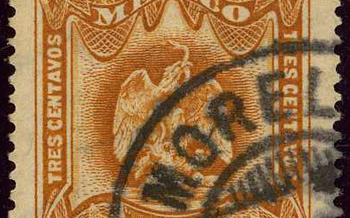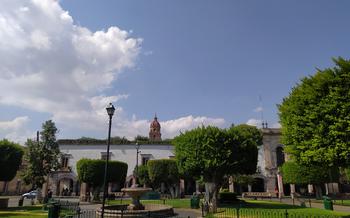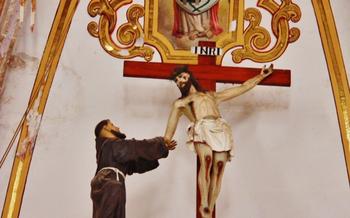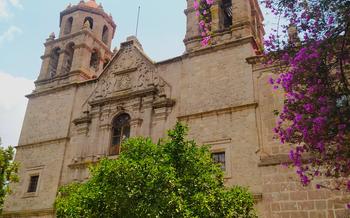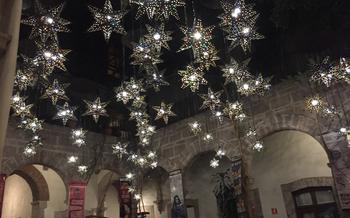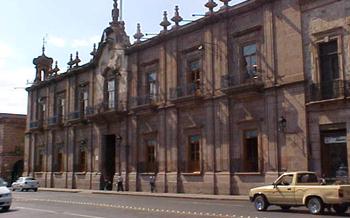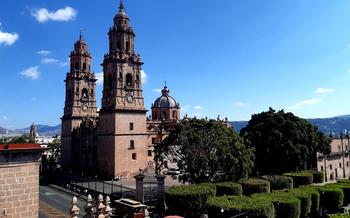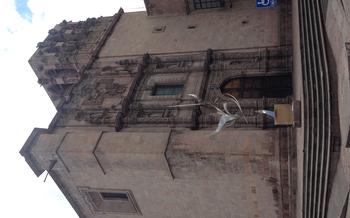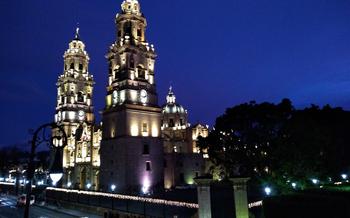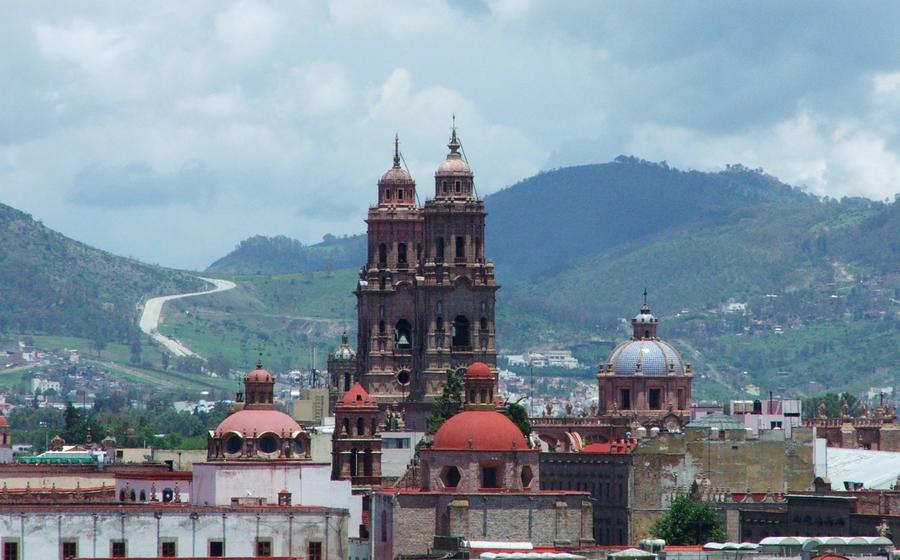
La Alberca en Zacapu
- The Rebirth of a City:
- A UNESCO City
- The Majestic Cathedral of Morelia
- Exploring the Centro Histórico
- The Museo del Estado de Michoacán: A Journey Through Michoacán's Cultural Heritage
- The Casa de las Artesanías de Michoacán: A Treasury of Traditional3, this remarkable institution serves as a hub for artisans and enthusiasts alike, offering a diverse array of handmade items that embody the rich traditions of Michoacán.
- The Plaza de Armas:
- The Acueducto de Morelia
- The Mercado de Dulces: A Sweet Treat for the Senses
- La Alberca en Zacapu: A Natural Oasis Awaits
- The Hacienda del Carmen
- The Santuario de Guadalupe: A Beacon of Faith and Devotion
- Insider Tip:
The Rebirth of a City:
Morelia, the capital of the in 1541 by Spanish conquistadors on the site of an ancient Tarascan settlement, Morelia played a crucial role in the development of colonial Mexico. It served as a center for mining, agriculture, and trade, and its strategic location on the Camino Real, the main trade route between Mexico City and the Pacific coast, contributed to its growth and prosperity.
The city's rich history is reflected in its architecture, which blends Spanish colonial and indigenous influences. Many of Morelia's most iconic landmarks, such as the Catedral de Morelia and the Acueducto de Morelia, date back to the colonial period. Morelia's cultural heritage is equally diverse, with a strong emphasis on music, dance, and the visual arts. The city is home to several museums, theaters, and art galleries, and hosts a variety of cultural festivals throughout the year.
Despite its colonial roots, Morelia is a vibrant and modern city with a population of over 800,000. It is a major educational and cultural center, home to the Universidad Michoacana de San Nicolás de Hidalgo, one of the oldest universities in Mexico. Morelia is also a popular tourist destination, attracting visitors from all over the world with its rich history, beautiful architecture, and vibrant cultural scene.
A UNESCO City
In 1991, Morelia was recognized as a UNESCO World Heritage Site, cementing its status as a city of exceptional cultural and historical significance. The designation highlights the city's unique fusion of Spanish and indigenous influences, evident in its architecture, cuisine, and traditions.
Morelia's historic center is a testament to the city's rich history and architectural prowess. Its colonial-era buildings, with their intricate facades and colorful tiles, create a captivating cityscape that transports visitors back in time. The city's many churches, plazas, and museums offer a glimpse into Morelia's vibrant past and ongoing cultural heritage.
The preservation of Morelia's cultural heritage is an ongoing endeavor, with local authorities and organizations working tirelessly to protect and restore the city's historic landmarks. Through careful restoration efforts and strict regulations, Morelia's architectural treasures continue to stand as a testament to the city's resilience and cultural significance.
The Majestic Cathedral of Morelia
The Catedral de Morelia stands as a testament to the city's rich history and architectural prowess. Its construction began in 1640 and spanned over a century, with various architects contributing to its unique blend of Gothic, Renaissance, and Baroque styles. The cathedral's imposing facade showcases intricate carvings, elaborate buttresses, and a grand central tower that dominates the skyline.
Inside, the cathedral's grandeur continues with its soaring vaulted ceilings, ornate altars, and stained glass windows that bathe the interior in a kaleidoscope of colors. The main altar, crafted from silver and gold, is a masterpiece of Baroque art, while the choir stalls feature intricate carvings depicting biblical scenes. The cathedral is also home to a collection of religious paintings and sculptures, including works by renowned artists such as Miguel Cabrera and Juan Correa.
Beyond its architectural and artistic significance, the Catedral de Morelia holds immense spiritual and cultural importance for the people of the city. It serves as the seat of the Archdiocese of Morelia and is a popular destination for pilgrims and worshippers from across the region. Throughout the year, the cathedral hosts various religious festivals and celebrations, drawing thousands of faithful who come to pay homage to the Virgin of Guadalupe, the patron saint of Morelia.
Exploring the Centro Histórico
In the heart of Morelia, the Centro Histórico stands as a testament to the city's rich history and vibrant culture. Declared a UNESCO World Heritage Site, this historic center is a treasure trove of colonial architecture, charming plazas, and cultural attractions.
A Walk Through Time
Strolling through the cobblestone streets of the Centro Histórico is like stepping back in time. Admire the elegant facades of palaces and churches, each adorned with intricate carvings and colorful tiles. The Plaza de Armas, the main square, is surrounded by grand buildings, including the Catedral de Morelia and the Palacio de Gobierno.
Cultural Delights
The Centro Histórico is not just a feast for the eyes, but also for the soul. Visit the Museo del Estado de Michoacán to delve into the region's history and culture, or explore the Casa de las Artesanías de Michoacán to discover a treasure trove of traditional crafts.
A Lively Atmosphere
The Centro Histórico is a hive of activity, with locals and tourists alike filling the streets. Street performers entertain the crowds, while vendors sell traditional snacks and souvenirs. Cafes and restaurants line the plazas, offering a chance to relax and soak up the atmosphere.
Tips for Exploring
- Walking Tour: The best way to explore the Centro Histórico is on foot. Join a guided tour to learn more about the history and architecture of the area, or wander at your own pace, getting lost in the charming streets.
- Comfortable Shoes: Wear comfortable shoes as you'll be doing a lot of walking. The cobblestone streets can be uneven, so sturdy footwear is recommended.
- Visit the Museums: The Centro Histórico is home to several museums, including the Museo del Estado de Michoacán and the Casa de las Artesanías de Michoacán. Take some time to explore these cultural gems and learn more about the region's history and traditions.
- Enjoy the Nightlife: The Centro Histórico comes alive at night, with bars and restaurants offering live music and entertainment. Take a stroll through the plazas and enjoy the vibrant atmosphere.
The Museo del Estado de Michoacán: A Journey Through Michoacán's Cultural Heritage
The Museo del Estado de Michoacán is a cultural treasure trove, showcasing the rich and diverse heritage of the state of Michoacán. Housed in a beautifully restored colonial building, the museum boasts a vast collection of artifacts, artworks, and interactive exhibits that tell the story of Michoacán's past and present.
As you step through the doors of the museum, you are greeted by a stunning array of archaeological artifacts, including ancient pottery, stone tools, and ceremonial objects. These relics offer a glimpse into the lives of Michoacán's earliest inhabitants and their sophisticated cultures.
The museum's collection also features an impressive array of colonial art, including paintings, sculptures, and religious objects. These works of art showcase the unique fusion of Spanish and indigenous influences that shaped Michoacán's cultural identity during the colonial period.
In addition to its permanent collection, the Museo del Estado de Michoacán regularly hosts temporary exhibits that showcase the work of contemporary artists from Michoacán and beyond. These exhibits provide a platform for local artists to share their unique perspectives and contribute to the ongoing cultural dialogue of the region.
The museum's interactive exhibits are a highlight for visitors of all ages. Through hands-on activities and multimedia displays, visitors can learn about Michoacán's history, culture, and traditions in a fun and engaging way.
The Museo del Estado de Michoacán is a must-visit for anyone interested in exploring the rich cultural heritage of Michoacán. With its diverse collection, interactive exhibits, and educational programs, the museum offers a truly immersive experience that will leave you with a deeper appreciation for the region's history and culture.
**The Casa de las Artesanías de Michoacán: A Treasury of Traditional3, this remarkable institution serves as a hub for artisans and enthusiasts alike, offering a diverse array of handmade items that embody the rich traditions of Michoacán.
Within the Casa de las Artesanías, visitors embark on a journey through the diverse expressions of Mexican artistry. The shelves and display cases are adorned with a kaleidoscope of textiles, pottery, jewelry, and decorative objects, each meticulously crafted by skilled artisans using techniques passed down through generations. Whether it's the intricate embroidery of a blouse, the vibrant colors of a ceramic plate, or the delicate filigree of a silver necklace, every piece tells a story of creativity, skill, and cultural identity.
This haven for artisans and art enthusiasts offers more than just a shopping experience; it provides a platform for cultural exchange and learning. Visitors have the unique opportunity to witness artisans at work, demonstrating their mastery with nimble hands and patient attention to detail. Workshops and demonstrations are regularly held, allowing visitors to delve deeper into the processes and techniques behind these exquisite creations.
The Casa de las Artesanías de Michoacán is not merely a marketplace; it is a testament to the enduring spirit of Mexican craftsmanship. By supporting local artisans and preserving traditional techniques, the institution plays a vital role in safeguarding the cultural heritage of Michoacán and ensuring its legacy for generations to come.
As you wander through the historic center of Morelia, the majestic Templo de San Francisco will undoubtedly capture your attention. This prominent architectural and religious landmark stands as a testament to the city's rich cultural heritage and enduring faith.
The construction of the temple began in the 16th century under the direction of Vasco de Quiroga, the first bishop of Michoacán. It took nearly two centuries for the structure to be completed, and the result is a remarkable fusion of Gothic, Renaissance, and Baroque styles.
The exterior of the temple is adorned with intricate carvings and sculptures, showcasing the skill and artistry of the indigenous craftsmen who labored on its construction. The main facade features a stunning rose window, which filters sunlight into the interior, creating a celestial ambiance.
Step inside the temple, and you will be awestruck by the grandiosity of its vaulted ceilings, elegant columns, and colorful murals. The altarpieces are adorned with intricate carvings and gilded details, creating a sense of awe and reverence.
The Templo de San Francisco is not merely a place of worship but also a repository of cultural and historical significance. Over the centuries, it has played a crucial role in shaping the identity of Morelia and the surrounding region.
Whether you are a devout believer or simply appreciate architectural marvels, the Templo de San Francisco is a must-visit destination in Morelia. Its impressive facade, awe-inspiring interior, and rich history make it a symbol of the city's enduring spirit and cultural heritage.
The Plaza de Armas:
In the heart of Morelia's Centro Histórico, the Plaza de Armas is a vibrant and historic square that serves as the city's main gathering place. Surrounded by elegant colonial buildings, the plaza is dominated by the majestic Catedral de Morelia, with its twin towers and intricate facade. The Palacio de Gobierno, with its distinctive pink quarry stone exterior, is another architectural highlight of the square.
Beneath the shade of towering trees, visitors can relax on benches and watch the world go by. Street performers entertain the crowds with music and dance, while vendors sell traditional Mexican snacks and souvenirs. Cafes and restaurants line the perimeter of the plaza, offering a variety of culinary delights and opportunities to soak up the lively atmosphere.
One of the best times to visit the Plaza de Armas is in the evening, when the square comes alive with music, laughter, and the sound of footsteps echoing through the cobblestone streets. During special events and festivals, the plaza transforms into a stage for concerts, dance performances, and colorful processions, showcasing the rich cultural heritage of Morelia.
Whether you're looking to admire the architectural wonders, soak up the local atmosphere, or simply relax and people-watch, the Plaza de Armas is a must-visit destination in Morelia.
The Acueducto de Morelia
The Acueducto de Morelia is an iconic landmark that symbolizes the city's engineering prowess and enduring legacy. Constructed in the 18th century, this impressive aqueduct stands as a testament to the ingenuity and determination of the people of Morelia. Its towering arches and pillars stretch for over a kilometer, gracefully traversing the city's historic center.
The aqueduct was built to address the city's growing water needs, channeling water from nearby springs to the city's fountains and homes. It served as a vital lifeline for Morelia's residents, providing them with a reliable source of fresh water. The aqueduct's intricate design and construction techniques showcase the skill and craftsmanship of the builders, using locally sourced materials and traditional methods.
Today, the Acueducto de Morelia stands as a symbol of the city's rich history and cultural heritage. It has been carefully preserved and restored, serving as a reminder of the city's resilience and the enduring spirit of its people. Visitors can explore the aqueduct on foot or by bike, admiring its architectural beauty and enjoying the panoramic views of the city and the surrounding countryside.
Whether marveling at its engineering prowess, appreciating its historical significance, or simply enjoying the breathtaking views, the Acueducto de Morelia is an essential destination for anyone visiting the city. It is a symbol of Morelia's enduring spirit and a testament to the ingenuity and creativity of its people.
The Mercado de Dulces: A Sweet Treat for the Senses
Located in the heart of Morelia's historic center, the Mercado de Dulces is a must-visit destination for anyone with a sweet tooth. This traditional Mexican market is a feast for the senses, with its vibrant colors, mouthwatering aromas, and friendly vendors eager to share their delicious creations.
A Culinary Adventure:
Strolling through the market, visitors are greeted by a dazzling array of sweets and candies, from traditional Mexican favorites like alfajores, cajeta, and chongos zamoranos to international treats like chocolates, gummies, and lollipops. Each stall is a treasure trove of sugary delights, inviting visitors to sample and savor the diverse flavors of Mexico.
A Taste of Tradition:
For those seeking an authentic Mexican experience, the Mercado de Dulces offers a chance to delve into the country's rich culinary heritage. Here, visitors can find traditional sweets that have been passed down through generations, each with its unique story and flavor. From the delicate rosca de reyes to the colorful calaveritas de azúcar, these sweets are not just treats but also cultural symbols.
Engaging with the Locals:
The Mercado de Dulces is more than just a place to buy sweets; it's also a vibrant social hub where locals and tourists alike come together to interact and share stories. Vendors are always happy to chat with visitors, offering recommendations and sharing their knowledge of Mexican sweets and traditions.
Insider Tip:
To truly immerse yourself in the experience, visit the market during one of the many festivals or celebrations held throughout the year. During these special events, the market comes alive with music, dancing, and even more sweets, making it an unforgettable cultural experience.
La Alberca en Zacapu: A Natural Oasis Awaits
La Alberca en Zacapu: Located just an hour's drive from Morelia, La Alberca en Zacapu is a natural swimming pool that offers a refreshing retreat from the city's hustle and bustle. This hidden gem is fed by crystal-clear spring water and surrounded by lush vegetation, creating a picturesque setting for a day of relaxation and adventure.
Unique Features: What sets La Alberca en Zacapu apart from other swimming pools is its natural beauty. The pool is surrounded by towering trees and colorful flowers, providing a tranquil ambiance that invites visitors to unwind and connect with nature. The water is crystal clear, allowing swimmers to see the colorful fish and aquatic plants that call the pool home.
Recreational Activities: In addition to swimming, La Alberca en Zacapu offers a variety of recreational activities for visitors of all ages. Fishing enthusiasts can cast their lines in the pool's clear waters and try their luck at catching a variety of fish species. Boating is another popular activity, with rowboats and canoes available for rent. Visitors can also enjoy hiking and biking trails that wind through the surrounding forest, offering stunning views of the pool and the surrounding countryside.
Tips for Visitors: To make the most of your visit to La Alberca en Zacapu, it's important to plan ahead. Bring comfortable clothing and swimwear, as well as sunscreen and insect repellent to protect yourself from the elements. It's also a good idea to bring a picnic lunch or snacks, as there are limited food options available at the pool. Remember to pack a camera to capture the stunning scenery and your memorable moments at this natural oasis.
The Hacienda del Carmen
A Glimpse into Morelia's Agricultural Heritage
The Hacienda del Carmen stands as a testament to Morelia's rich agricultural history. Originally established as a sprawling estate dedicated to farming and livestock, the hacienda has undergone a transformation, evolving into a vibrant cultural center that preserves and showcases the region's heritage.
Visitors to the Hacienda del Carmen are greeted by a majestic main house, a testament to the architectural grandeur of the era. Its thick walls, arched doorways, and intricate ironwork speak to the skilled craftsmanship of the past. The surrounding gardens, a riot of color and fragrance, transport visitors to a bygone era, where nature and agriculture intertwined seamlessly.
Beyond its architectural charm, the Hacienda del Carmen plays an active role in preserving Morelia's cultural traditions. Throughout the year, the hacienda hosts a variety of events and workshops that celebrate local crafts, cuisine, and music. Visitors can immerse themselves in traditional dance performances, learn the art of pottery or weaving, and savor the flavors of Michoacán's regional dishes.
A visit to the Hacienda del Carmen is a journey into the heart of Mexico's agricultural heritage. It is a place where history, culture, and nature converge, offering visitors a glimpse into the vibrant traditions that have shaped Morelia's identity.
The Santuario de Guadalupe: A Beacon of Faith and Devotion
Located onlia's most revered religious sites. Constructed in the 18th century, the sanctuary is a testament to the deep devotion of the Mexican people to the Virgin of Guadalupe, the patron saint of Mexico.
Architectural Grandeur: The sanctuary's striking architectural features, including its domed roof, intricate facade, and colorful interior, are a testament to the skill and artistry of the builders. The domed roof is particularly impressive, as it is one of the largest in Mexico. The interior of the sanctuary is adorned with beautiful murals and paintings depicting scenes from the life of the Virgin of Guadalupe.
Pilgrimage Destination: The Santuario de Guadalupe is a popular pilgrimage site for Catholics from all over Mexico. Every year, thousands of pilgrims flock to the sanctuary to pay homage to the Virgin of Guadalupe and seek her blessings. The sanctuary is particularly busy during the annual Feast of Our Lady of Guadalupe on December 12th, when pilgrims from all over the country come to celebrate and participate in the festivities.
Religious Festivals: Throughout the year, the sanctuary hosts various religious festivals and celebrations. These festivals are a vibrant display of Mexican culture and devotion, featuring traditional music, dance, and food. Visitors can experience the fervor and joy of the Mexican people as they come together to celebrate their faith and pay homage to the Virgin of Guadalupe.
Tips for Visitors: To make the most of your visit to the Santuario de Guadalupe, consider the following tips:
-
Best Time to Visit: The best time to visit the sanctuary is during the annual Feast of Our Lady of Guadalupe on December 12th, when the sanctuary is at its most lively and vibrant. However, if you prefer a quieter and more contemplative experience, visit during the off-season.
-
Dress Code: As a religious site, visitors are expected to dress respectfully. Avoid wearing shorts, tank tops, or revealing clothing.
-
Photography: Photography is allowed inside the sanctuary, but be respectful of the worshippers and avoid using flash photography.
-
Guided Tours: Guided tours of the sanctuary are available in Spanish and English. Tours provide a deeper insight into the history, architecture, and religious significance of the sanctuary.
Insider Tip:
For a unique and immersive experience, venture off the beaten path to the La Alberca en Zacapu, a natural swimming pool located just outside of Morelia. This hidden gem is a favorite spot for locals to escape the summer heat and enjoy a refreshing dip in the crystal-clear waters. Surrounded by lush vegetation and towering cliffs, the pool offers stunning views and a tranquil atmosphere. You can spend the day swimming, fishing, or simply relaxing on the shore, soaking up the sun and enjoying the beauty of nature. To get to La Alberca en Zacapu, take a bus from Morelia to the town of Zacapu, and then a taxi or colectivo to the pool. Remember to bring your swimsuit, towel, and sunscreen, as there are no facilities available at the site.
